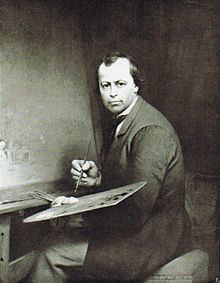Name Ferdinand Braekeleer | ||
 | ||
Ferdinand de Braekeleer (Antwerp, 12 February 1792 – Antwerp, 16 May 1883), sometimes spelled as Ferdinand de Braeckeleer, was a Flemish painter. He is known for his historical paintings and is called 'the Elder' to distinguish him from his son with the same name (Ferdinand de Braekeleer the Younger), who was also a painter.
Contents
Life
Ferdinand was born in a poor family. After his parents died he was admitted to the Art school for orphans of Mathieu Ignace van Brée in Antwerp. He continued his education at the Royal Academy for Fine Arts of Antwerp. His paintings received several prizes in 1809 and 1811. In 1813 he made his reputation at the Salon de Paris with his work Aeneas die Anchises redt uit de brand van Troje ("Aeneas saving Anchises from the fire of Troy").
Early on, De Braekeleer decided that he wanted to make a living as a painter and he tried out several genres to find out which one would most likely bring him most success. In addition to historical paintings, he also painted religious paintings, such as St. Sebastiaan for the Church of Our Lady of the Vineyard in Wijnegem (current location unknown).
At the Antwerp art exhibition of 1819 he exhibited four paintings, of which Tobias bezorgt het zicht aan zijn vader terug (Tobias Restoring his Father's Sight) won him the Dutch Prix de Rome in the category of historical paintings. This prize provided him with a scholarship that allowed him to study in Italy to improve his skills. He spent 1821 and 1822 in Italy. Together with his tutor Van Brée (who joined him in Rome) he visited several Italian cities, including Naples, Ancona, Firenze, Bologna and Venice. Fascinated by these Italian cities and their landscape, he filled a sketch book with crayon drawings of landscapes and city views, which is currently on display in the Bibliotheque Royale Albert (Royal Albert Library) in Brussels.
After his return to Belgium, De Braekeleer lived in his home town Antwerp. He created works inspired by the old Flemish masters. He primarily focused on historical paintings. One of these is the painting De Citadel van Antwerpen na het bombardement van 1832 (The citadel of Antwerp after the bombardment of 1832). Partially because of his paintings about the 1832 bombardments by the Dutch, he became an influential artist in Belgium after the independence of Belgium. His two sons, Ferdinand the Younger (1828 - 1857) and Henri de Braekeleer (1840 - 1888) followed in their father's footsteps and also became painters. His nephew Adriaan Ferdinand de Braekeleer (1818 - 1904), was also a painter. Besides his sons, he tutored several other painters who became influential, such as Jan August Hendrik Leys and Ernest Slingeneyer.
Pupils
Work
(incomplete overview)
